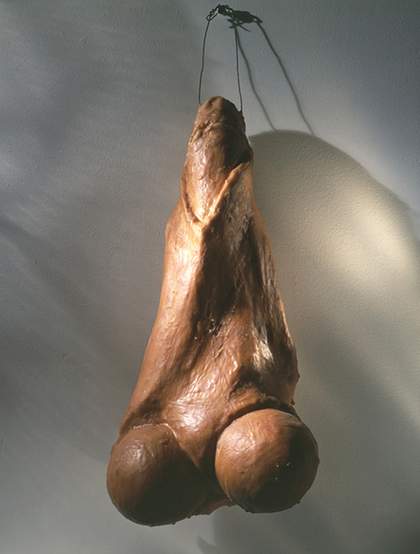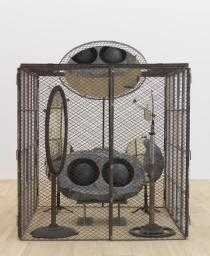
Louise Bourgeois
Fillette 1968
Latex over plaster
59.5 x 26.5 19.5 cm
Estate of Peter Moore, Museum of Modern Art, New York © Louise Bourgeois
Does size matter for women? In terms of fame, apparently, it does. Traditionally female artists struggle to balance the scale and ambition of their creativity with their sexual and maternal roles, to their inevitable critical detriment.
As Whitney Chadwick notes in her classic Women, Art, and Society women’s “attempts to juggle domestic responsibilities with artistic production have often resulted in smaller bodies of work, and often works smaller in scale, than those produced by male contemporaries. Yet art history continues to privilege prodigious output and monumental scale or conception over the selective and the intimate”.
But Louise Bourgeois, painter, sculptor, mother, has been prodigiously productive and monumental, as well as delicate and subtle. She has always refused timidity or compromise in her art. As she wrote to a woman friend in 1939: “To convince others, you have to convince yourself; and a conciliatory or even an unduly understanding attitude – in that it is inevitably superficial – is not helpful to creativity.” A fierce contender in the art world, she speaks for women’s need to fight their corner: “A woman has no peace as an artist until she proves over and over that she won’t be eliminated.”
Since the mid-1970s Bourgeois has been a magnetic figure for art critics, especially feminist art historians and theorists. Her sculpture and installations can be repellent and sinister as well as erotic and sensual. Her sculpture, with its lumps, bumps, bulbs, bubbles, bulges, slits, turds, coils, craters, wrinkles and holes, can be slick and shiny, or rough and jagged. Her themes are highly personal, including her parents and childhood in France, her domestic confinement and transcendence, her interest in a French tradition of hysteria and creativity. But these subjects are also connected with larger issues, especially of gender.
Bourgeois has written a great deal about her childhood and family in Aubusson, “a part of France… where there is nothing but granite, as in Brittany, which is famous for its lace; the same combination of stone and needlework in both. The women wove and the men cut stone in the quarries”. Her mother “was a tapestry restorer. She employed about twenty girls and this group of weavers had an influence on me as a woman and as an artist”. Louise helped with tapestry restoration, drawing missing feet and even horses’ hoofs. From an early age, she noted, her mother “acquainted me with the problems of drawing and colour and the various historical styles of old tapestries. There were also the chemical problems of finding unfading dyes”.
In some respects, her childhood resembled that of Matisse, who grew up in Bohain in a community of silk-weavers, surrounded by looms and textiles. But while Matisse retained and used his memories of glowing, vivid colours and sensual textures, Bourgeois inherited a darker vision, and deliberately worked with a more constrained palette. Mme Bourgeois was a passionate feminist, a follower of the activist Louise Michel, after whom her daughter was named. But feminism did not protect her from her husband’s infidelities, as her daughter angrily observed. Louise describes herself as a child “desperate to please”, aware of the operations of power in the family. But by the time she got to school she was “terribly competitive”, and soon moved to Paris to study painting. In France, however, the system of art training was an apprenticeship, a set of tasks such as doing tapestry, and more imitative than she liked. She studied the great masters, but was determined to oppose them and to find her own style.
When she married an American art historian, Robert Goldwater, in 1938 and moved to New York, Bourgeois left behind a traditional, apprenticed and practical part of her life, associated with women, memory and her mother, and entered what was to her a more masculine modern, professional, independent and creative culture. These two modalities would alternate and combine in her work. In New York she raised three sons, “found a flourishing artistic milieu” and realised that her paintings weren’t big enough: “There is a timidity in the way the idea is presented.” By 1945 she had her first solo show. In these early paintings, titled in English, she observed a change: “Even though I am French, I cannot think of one of these pictures being painted in France. Every one of these paintings is American, from New York. I love this city, its clean-cut look, its buildings, its scientific, cruel, romantic quality.” In 1951 she became a US citizen. But aspects of her French upbringing continued to shape her work and her self-presentation. In contrast to American woman painters of the 1940s, she was glamorous and elegant; in contrast to her feminist cohorts in the 1960s and 1970s, she remained detached from politics and headlines.
A major theme of her work in the 1940s, however, was female confinement in the home. In a series of drawings and paintings she portrayed the femme maison – the house woman or housewife – some with houses for heads, or rooms for bodies. Bourgeois would return to the femme maison throughout her career, exploring women’s imprisonment in a “home” that was both a cage and the maternal body. Like American woman writers in the 1940s and 1950s, particularly Carson McCullers and Shirley Jackson, both agoraphobic, the artist was drawing upon the literary genre of the female Gothic, in which a young woman seeks out a secret inner room, which is the source of mysteries, including birth and death. As Anne Sexton wrote in her poem Housewife, the house was the female body, endlessly requiring maintenance, trapping the female artist in her biology.
In the late 1960s and through the 1970s many American women artist were drawing on images from the body. Judy Chicago’s The Dinner Party 1974–9, now permanently installed in the Brooklyn Museum of Art, used crafts techniques, including tapestry, embroidery and patchwork, as well as sculpture to represent famous women throughout history in concentric, petalled, vaginal forms. As the dinner guests enter the twentieth century, the vaginal shapes become three-dimensional, rising up from their surface in ways some have found beautiful, others essentialist and reductive, and still others threatening.
Bourgeois has certainly used female sexuality in her work, but by the 1960s she was more androgynous or even masculine in her choices of subject. Her most famous and most photographed “erotic” work is her latex sculpture Fillette 1968, which playfully confuses genders. While it is obviously a 2ft-long phallus, it is comic and diminishing rather than commanding. Bourgeois emphasised her jokey French name for the object – a little girl – by calling it “a little Louise”. In one photograph, suspended, it resembles a toy clown in a hat and overcoat with big round boots. In a celebrated photograph by Robert Mapplethorpe, she holds it tucked casually under her arm like a baguette.
In the 1990s Bourgois combined her themes of confinement, sexuality and power in a series of cages, or cells. “The Cells represent different types of pain,” she wrote in 1991, “the physical, the emotional and psychological and the mental and intellectual.” Some referred specifically to the French neurologist Jean-Martin Charcot and his clinic for hysterics at the Salpêtrière Hospital in Paris in the 1880s. In the French tradition, hysteria had long been regarded by artists as a state of the creative process, and artists, writers and actors flocked to Charcot’s Tuesday public lectures at the Salpêtrière, where he exhibited hysterical patients, including many men. He described male hysterical attacks as being cause by fear, but used a different vocabulary from the one he applied to the histrionic, spiritual women, calling some male movements “clownisme”, and praising the athleticism of his subjects’ seizures: Gui, one patient, produced an “acrobatic performance as beautiful as it was varied”, with the grand finale of the arc en cercle or hysterical arch. While many contemporary female artists, such as Mary Kelly, have been drawn to the iconography of female hysteria, Bourgeois emphasised male emotions and sexuality. In Cell (Arch of Hysteria) 1993, the headless male body is cast in polished bronze inside a cage; in another work, it is suspended from a string, portraying both power and vulnerability.
In 1997 Bourgeois exhibited a cage upon which was perched an enormous spider sculpted in bronze, its legs completely covering the wire enclosure. For some years she had been drawing and sculpting spiders, both friendly and ominous. All, she claimed, represented her feelings about her mother. In one 1994 sketch, in the red ink she associated with blood, was titled Spider (L’Indispensable). Indispensable was a word she frequently used about her mother: “My best friend was my mother and she was deliberate, clever, patient, soothing, reasonable, dainty, subtle, indispensable, neat and as useful as a spider… I shall never tire of representing her.”
But indispensable can also mean inescapable. Maman 1999, the gigantic spider in her installation at Tate Modern, towers over us, the mother as colossus, woman as weaver and spinner of stories. Now 96 and still producing powerful and surprising work, Bourgeois has disproved all assumptions about the artistic careers of women.


